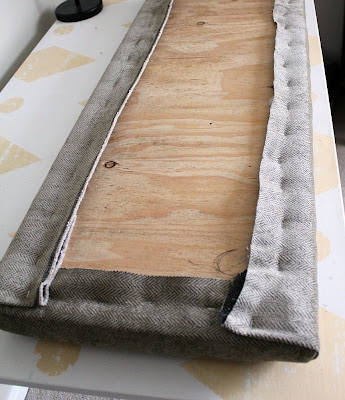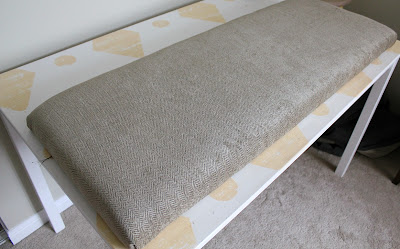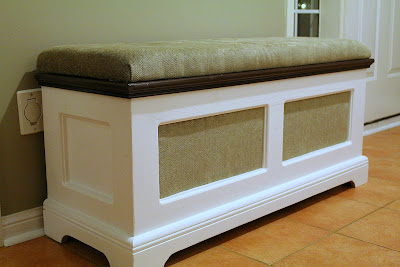Way back in April of 2012 I bought a bench at our company yard sale. For $2. Quite a bargain, right? And this past weekend I got around to refurbishing it.
Do you remember it before? It's a very solid piece of furniture, with a slapped on paint job. It was for background in a photo shoot, so I'm sure they weren't too worried about the quality of the work at the time.
I popped out the front fabric panel inserts and gave the sides a fresh coat of white paint, then painted the top with a paint and poly in one in brown. I really wanted to stain and poly the top, but it's only made of particle board, so no wood grain for me.
After work on Friday I bought some 2" foam, quilt batting, and upholstery fabric with a bit of a herringbone pattern. I had Tom cut down a piece of plywood to the same size as the top of the bench and used that as my base for the cushion.
While he was cutting the board, I recovered the front inserts in the same fabric. The inserts were made up of a thin piece of plywood, an even thinner piece of batting, and then the dropcloth material. Recovering it was a simple matter of removing the old fabric by pulling out the staples, cutting a new piece of fabric - make sure you leave enough on each side to wrap to the back - and stapling it to the back of the board. It really only took about 10 minutes. (Four of which were spent finding a heavier stapler than the one I thought I could use.)
I handed the inserts off to Tom to reinstall, and got to work on the cushion. I cut the foam to size and then spray glued it to the plywood board. The glue isn't there to do more than keep the foam in place while I'm pulling on the fabric, it's not really strong enough to hold something with this amount of weight.
I measured out a piece of quilt batting that would cover the front and sides, and wrap to the back by a couple of extra inches. I flipped the foam and board upside down on the batting, wrapped it tightly to the back and got to stapling. You'll want to start by stapling the batting to the center of each side of the board, to get it anchored firmly. You can then flip it back over and make sure that everything is smooth and there isn't any gapping. I usually work on the corners next. I folded the batting material to get nice clean corners - kind of like wrapping a present - and then stapled it down.
I then filled in with more staples between the center and the corner of each side. Make sure you keep pulling the material taut all along. You may want to have someone else hold it for you if you need two hands to work the stapler.
I repeated the process with the upholstery fabric. If you want to have tidy edges, see here for a tutorial. The underside wasn't going to show in this case, so it didn't matter what it looked like.
I've sewn the corners before (here and here), and done a double-fold (my favourite, I'll have to take pictures sometime), but I kept this one simple - just tucked one side in and folded the other over.
See how easy that was? We then drilled four holes in the top of the bench and attached the cushion to the top from underneath with screws. Make sure they aren't too long - you don't want to poke someone in the butt!
Here you can see the detail of the front panels.
Now a little before and after:
I was considering painting the side inserts the same colour as the wall behind the bench, but I think I might just add some antique-looking handles instead.
The best thing is that now we have somewhere to sit to put our shoes on. No more sitting on the floor and getting slobber-attacked by dogs!




















7 comments:
Beautiful!
Jenny
www.simcoestreet.blogspot.ca
I love it! I have a bench I need to do this to!
Beautiful work. following on Facebook. Linda
http://www.craftsalamode.com/2013/06/what-to-do-weekends-26.html
That is gorgeous!! Great job! Thanks so much for sharing at Thursday's Temptation. I am going to be featuring your bench at tonight's link party!
This looks so amazing! A complete transformation AND way more comfortable :) Love it!
Thanks, Jill!
Oh, you should! It only took a couple of days (mostly waiting for paint to dry) and it's such an improvement!
Post a Comment